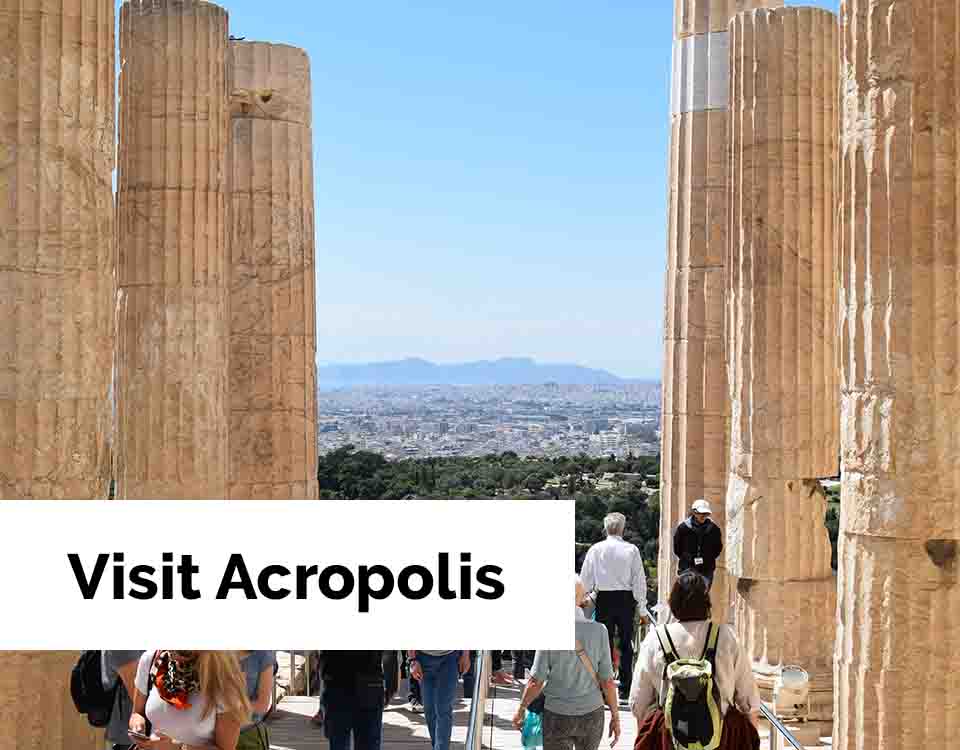
17/03/2020
 When you think about a city break to Athens, you surely think about visiting the Acropolis. What the Colosseum is for Rome, is the Acropolis for Athens: the top attraction of the capital. It is one of the most popular things to see during a stay in Athens. Although you might be familiar with pictures of the temples on top of the hill, you may not be aware of some things that are good to know before you go. This blog post shares some top tips to make the most out of your Acropolis visit.
When you think about a city break to Athens, you surely think about visiting the Acropolis. What the Colosseum is for Rome, is the Acropolis for Athens: the top attraction of the capital. It is one of the most popular things to see during a stay in Athens. Although you might be familiar with pictures of the temples on top of the hill, you may not be aware of some things that are good to know before you go. This blog post shares some top tips to make the most out of your Acropolis visit.
ACRO (edge) + POLIS (city) = highest point of the city
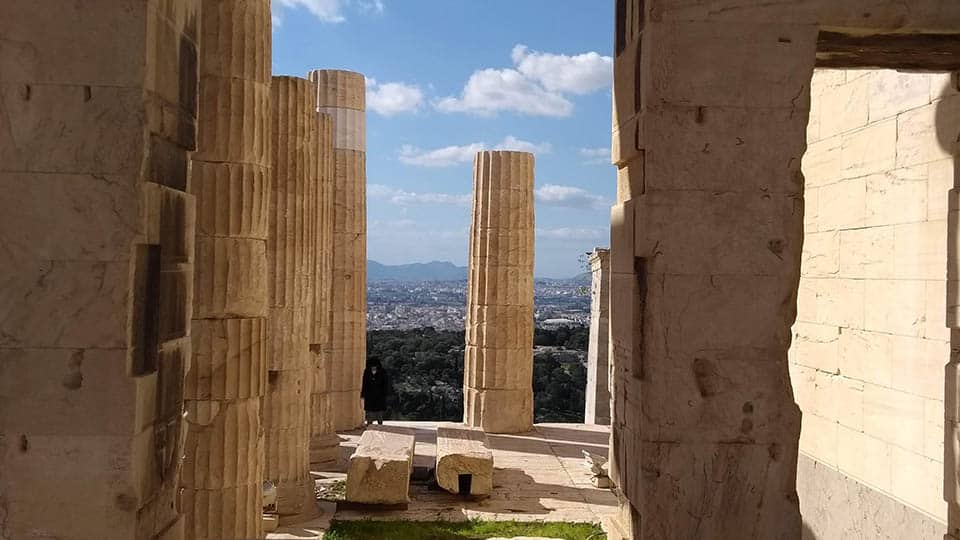
Photo: Athens' view through Propylaea
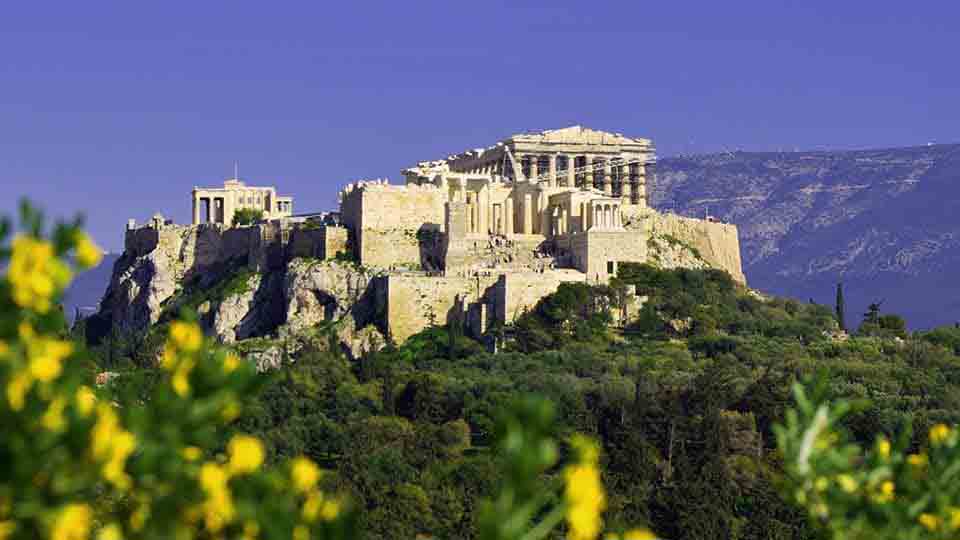
Photo: Acropolis Hill in the morning
Fall (September 1st – October 31st): 8:00-19:30/17:00
Winter: (November 1st - March 31st): 8:00-17:00
You can enter the Acropolis site 30 minutes before closing time.
•1 January: New Year’s Day
•25 March: Greek Independence Day
•1 May: Labor Day
•Easter Sunday: Greek Orthodox Easter*
•25 December: Christmas
•26 December: Christmas
*Usually Friday and Saturday before Greek Orthodox Easter, the Acropolis operates fewer hours than normal.
In our opinion, the best season to come and see the Acropolis is surprisingly wintertime! Athens has a good climate during the WINTER with some nice sunny days and blue skies. In general, it’s much quieter in the city with fewer tourists. It might even be possible to have a picture of the Parthenon with no other people in it! Furthermore, during the winter, entrance fees are half price.
More info about planning your city break to Athens can be found in our blog post 4 Seasons: The Best Time to Visit Athens.
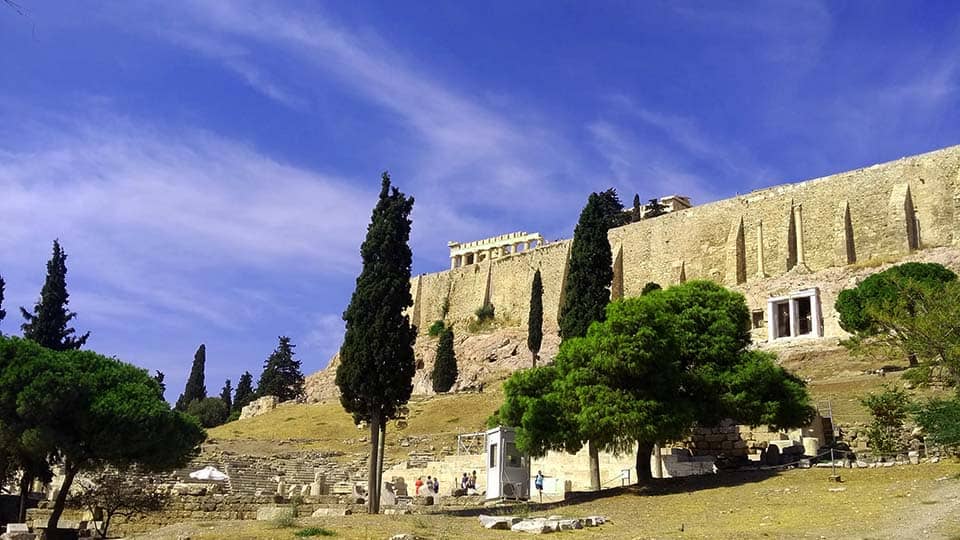
Photo: Acropolis archaeological site in February
Frankly speaking, the best time to climb the Acropolis hill is as early as possible. Especially during summer when it can be very hot, you better begin your day early before the hill starts heating up. As a result, you have all day in front of you after your Acropolis visit! Afterward, when it’s warmer outside, you could marvel at the original sculptures in the nice and cool, airconditioned Acropolis Museum.
You can read all information about Acropolis tickets and entrance fees in our blog post How to get Acropolis Tickets.
There are three entrances to the archaeological site of the Acropolis hill:
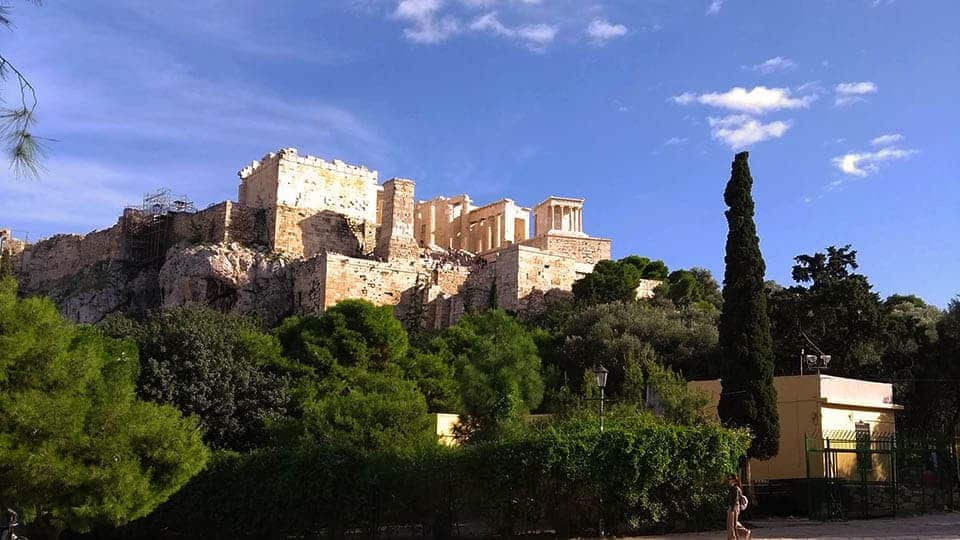
Photo: Main entrance of the Acropolis Hill
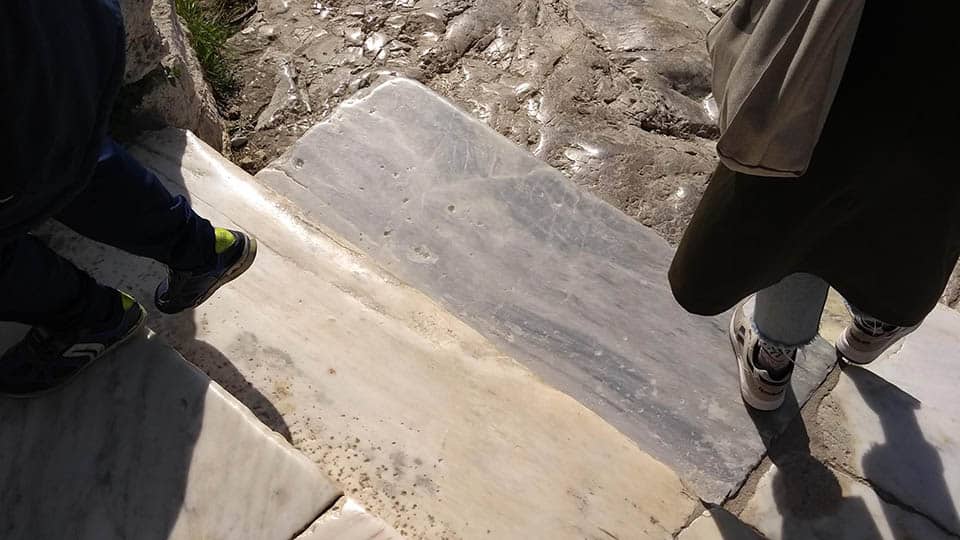
Photo: Slippery surfaces on the Acropolis Hill
The Acropolis is a hill of 156 meters/ 512 feet high and there is no lift. This means you have to walk all the way up on foot. Usually, it’s not a problem, when you take your time at the several monuments you pass. The Acropolis has about 2 million visitors a year, who all walk up the hill. It’s definitely worth it!
On the other hand, it is a rocky hill with ramps and steps to the top, so please consider this if you have walking or physical limitations.
Average speaking you need around 1.5 - 2 hours to ascend the hill and see the monuments of the Acropolis. Of course, you can spend as long as you want and taking as many pictures as you wish, then add some extra strolling and picture time to it.
The Acropolis is an archaeological site that should be treated with respect. For this reason, not everything is allowed. So, here’s a list of what you should not do:
A guided tour is fun and relaxing! When you book a tour with us, we take away the stress around your Acropolis visit.
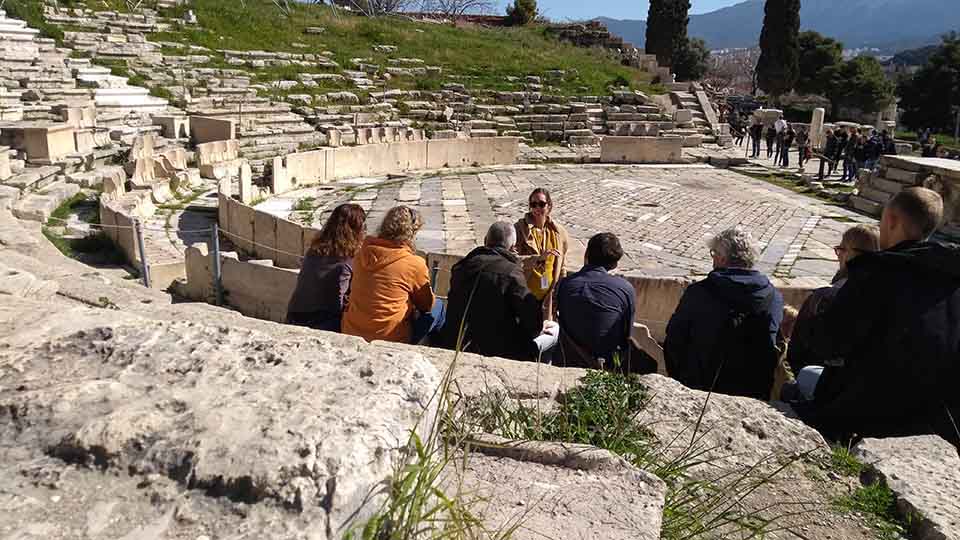
Photo: Guided tour in the ancient theatre of Dionysus, Acropolis Hill
Make sure to check the official website before visiting the Acropolis for UpToDate information.
 When you think about a city break to Athens, you surely think about visiting the Acropolis. What the Colosseum is for Rome, is the Acropolis for Athens: the top attraction of the capital. It is one of the most popular things to see during a stay in Athens. Although you might be familiar with pictures of the temples on top of the hill, you may not be aware of some things that are good to know before you go. This blog post shares some top tips to make the most out of your Acropolis visit.
When you think about a city break to Athens, you surely think about visiting the Acropolis. What the Colosseum is for Rome, is the Acropolis for Athens: the top attraction of the capital. It is one of the most popular things to see during a stay in Athens. Although you might be familiar with pictures of the temples on top of the hill, you may not be aware of some things that are good to know before you go. This blog post shares some top tips to make the most out of your Acropolis visit.
1. Reasons to visit the Acropolis
TOP 1 SIGHT in ATHENS
The Acropolis is THE highlight of Athens. That is also what the word “Acropolis” literally means: the highest point of the city. A high point gives you also a stunning view of the city that spreads itself all around you.ACRO (edge) + POLIS (city) = highest point of the city

UNESCO
The Acropolis is listed in the World Heritage List of UNESCO. The site represents a universal symbolism of Greek civilization, which is expressed by the well-preserved monuments on the hill. These monuments were created during the flourishing period of Athens in the fifth century B.C.E. Without a doubt, their architecture and decorative art were and still are a source of inspiration for architects and artists worldwide.WORLD-FAMOUS MONUMENTS
The world-famous Parthenon temple, the Erechteion with its Caryatids, the Propylaea, the temple of Athena Nike, and the theater of Dionysos are some of the world-famous monuments on the Acropolis. These monuments were built during the classical period. In this time, also democracy, Greek theater, and philosophy develop in Athens for the first time in history.
2. Opening times of the Acropolis
OPEN DAILY
The Acropolis is open seven days a week, with the exception of some National Holidays. Please see further down. The basic rule is when the sun is shining, the Acropolis is open. In summer the Acropolis is open longer than in winter. In Fall the opening times shorten slowly to switch to the opening times in winter.SEASONS
Summer (April 1st – Aug 31st): 8:00-20:00Fall (September 1st – October 31st): 8:00-19:30/17:00
Winter: (November 1st - March 31st): 8:00-17:00
You can enter the Acropolis site 30 minutes before closing time.
3. Sometimes the Acropolis is closed
NATIONAL HOLIDAYS
The Acropolis is closed on some National Holidays:•1 January: New Year’s Day
•25 March: Greek Independence Day
•1 May: Labor Day
•Easter Sunday: Greek Orthodox Easter*
•25 December: Christmas
•26 December: Christmas
*Usually Friday and Saturday before Greek Orthodox Easter, the Acropolis operates fewer hours than normal.
HOT SUMMER DAYS
When temperatures rise over 40° Celsius in summer, the Acropolis closes around noon. The Acropolis is a hill and on top, there is not a lot of shade. These are the reasons why it may not be the best choice to climb the Acropolis at noon on a hot summer day. In the afternoon, usually from 15:00 o’clock, the archaeological site opens again until 20:00.STRIKES, VIPS, or UNFORSEEN EVENTS
In other rare cases, the Acropolis can be closed. Firstly, sometimes people strike for better working conditions. Secondly, political leaders can pay a visit to the Acropolis. And lastly, there could be some other unforeseen circumstances, like bad weather conditions or epidemics. In these cases, the Acropolis will be (temporarily) closed for regular visitors.4. The best season to visit the Acropolis is…. WINTER!
In our opinion, the best season to come and see the Acropolis is surprisingly wintertime! Athens has a good climate during the WINTER with some nice sunny days and blue skies. In general, it’s much quieter in the city with fewer tourists. It might even be possible to have a picture of the Parthenon with no other people in it! Furthermore, during the winter, entrance fees are half price.
More info about planning your city break to Athens can be found in our blog post 4 Seasons: The Best Time to Visit Athens.

5. Arrive early
Frankly speaking, the best time to climb the Acropolis hill is as early as possible. Especially during summer when it can be very hot, you better begin your day early before the hill starts heating up. As a result, you have all day in front of you after your Acropolis visit! Afterward, when it’s warmer outside, you could marvel at the original sculptures in the nice and cool, airconditioned Acropolis Museum.
6. Purchase your Acropolis tickets in advance
You can read all information about Acropolis tickets and entrance fees in our blog post How to get Acropolis Tickets.
7. The Acropolis has more than 1 entrance
There are three entrances to the archaeological site of the Acropolis hill:
THE MAIN ENTRANCE
First of all, the main entrance is located on the west side of the Acropolis hill. On this side of the hill, you find the neighborhood of Thisseio. The main entrance is the entrance where a taxi can drop you off as close as you can get by taxi. When you tell a taxi driver that you want to go to the Acropolis, this is where he will take you. The gate of the main entrance is already a bit up the hill. Choose this entrance if you have a limited amount of time and want to do a fast track and marvel at the monuments on top of the hill. This is also the entrance you have to take when you are using a wheelchair, and where you can store big luggage and strollers.
THE SOUTH ENTRANCE
The second entrance is located on the south side of the Acropolis hill. It’s opposite the new Acropolis Museum and close to the metro station Acropoli. This is on the borders of the neighborhoods Plaka and Koukaki. From here you ascend the hill from the south slope, the sunny side of the Acropolis. The way up is a bit longer than from the main entrance, but you ascend slowly by a ramp and pass by some more monuments (theater of Dionysos and the sanctuary of Asklepios). This is the entrance we use during our Acropolis Tour.THE NORTH ENTRANCE
There used to be a third entrance on the north side, on the side of Plaka, close to Monastiraki. Unfortunately, since a few years this entrance is permanently closed.8. Top tips to know before you go
IT’S HOT
Greece can be hot in summer with temperatures in Athens around 30° Celsius. Therefore, it’s a good idea to wear sun protection, such as sunscreen and a hat, and bring a bottle of water with you.SLIPPERY SURFACES
The Acropolis is a natural hill with steps, ramps and slippery rocks. Everything that shines is slippery, even when it doesn’t rain. We highly recommend walking carefully and wearing comfortable shoes.
PICKPOCKETS
The Acropolis is a busy place. Unfortunately, in all crowded, tourist places around the world, you should be careful with your belongings, because there can be pickpockets. Consequently, please be careful with your personal belongings, also on the Acropolis sight.9. Be prepared to walk up the Acropolis hill
The Acropolis is a hill of 156 meters/ 512 feet high and there is no lift. This means you have to walk all the way up on foot. Usually, it’s not a problem, when you take your time at the several monuments you pass. The Acropolis has about 2 million visitors a year, who all walk up the hill. It’s definitely worth it!
On the other hand, it is a rocky hill with ramps and steps to the top, so please consider this if you have walking or physical limitations.
10. Schedule enough time for your visit
Average speaking you need around 1.5 - 2 hours to ascend the hill and see the monuments of the Acropolis. Of course, you can spend as long as you want and taking as many pictures as you wish, then add some extra strolling and picture time to it.
11. Not everything is allowed
The Acropolis is an archaeological site that should be treated with respect. For this reason, not everything is allowed. So, here’s a list of what you should not do:
TOUCH the MARBLE
It’s very tempting when you are so close, I know, but it’s not allowed to touch any of the marble. There are warning signs, that say, “DON’T TOUCH THE MARBLE” and there are guards who blow their whistle if somebody does something that’s not allowed. So, don’t put your water bottle by accident on a “stone” behind a rope, because you will hear a whistle.CLIMB
Climbing rocks and the surrounding walls of the Acropolis can be dangerous and is therefore not allowed for your own safety.EAT – DRINK – SMOKE
The Acropolis is an outdoor space but should be considered as a museum in the open-air. In order to keep the place clean, it’s not allowed to picnic, eat, drink or smoke. Since it can get very hot, it is allowed and highly recommended to take water with you.PICTURES
Of course, you can take as many pictures as you wish, even with flash. However, there are some limitations to what is excepted on a photo. Out of respect for the century-old monuments, it is not permitted to pose, show naked provoking body parts, or wear costumes. Pictures with flags, mascots, or other obvious objects are not allowed with the Acropolis monuments in the background.DRONES
New technology makes it possible to fly over the Acropolis hill and take some beautiful shots from above. Know that for taking pictures or videos with drones, you need special permission.STROLLERS
People of any age can visit the Acropolis hill. Also, the youngest ones who cannot walk themselves are more than welcome. But, please note that you cannot take (baby)strollers inside the archeological site of the Acropolis. Strollers can be left free of charge at the main entrance. Since the Acropolis is not stroller-friendly, we strongly recommend carrying your little one in a baby carrier.BIG LUGGAGE
The Acropolis is a huge rocky hill with uneven terrain. This means that it’s not convenient to take luggage or big bags with you on your way up. Baggage can be left at the main entrance.12. Book a guided tour
A guided tour is fun and relaxing! When you book a tour with us, we take away the stress around your Acropolis visit.

SKIP THE LINE
When you book an Acropolis Tour or Acropolis & Acropolis Museum Tour with us, we will arrange your tickets. You don’t have to worry about how to get them and stand in line, we do that for you!We know where to STOP
We design the itinerary of the tour and spend a reasonable amount of time at each monument we pass by. Apart from hearing myths and stories about the Acropolis, you will appreciate the monuments better when you can place them in a historical context. You will understand what you see around you.EASY
It’s easy to have a guide. Especially when the tour is in your own language (Dutch or German) and you are traveling with children; the guide entertains and informs the kids. You don’t have to prepare or read anything: we do the work. Just listen and enjoy what you see around you.Make sure to check the official website before visiting the Acropolis for UpToDate information.

